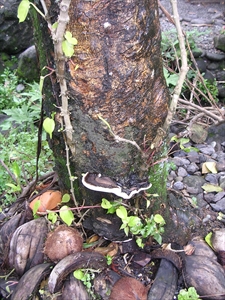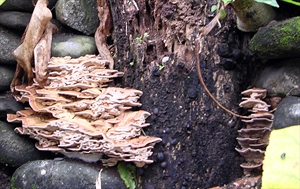Butt and root rot
Pacific Pests, Pathogens, Weeds & Pesticides - Online edition
Pacific Pests, Pathogens, Weeds & Pesticides
Citrus butt & root rot (004)
Ganoderma and Trametes. There are many species of both, and not all are plant pathogens, especially those belonging to Trametes. Also, see Casuarina butt rot caused by Ganoderma applanatum (Fact Sheet no. 195).
Ganoderma species are present in American Samoa, Australia, Cook Islands, Federated States of Micronesia, Fiji, French Polynesia, Marshall Islands, New Caledonia, Niue, Papua New Guinea, Samoa, Solomon Islands, Tonga, Tuvalu, and Vanuatu. They have been recorded on citrus in Cook Islands, Fiji, and Solomon Islands.
Oranges and other citrus species are attacked. These fungi have a wide host range and infect many forest and plantation trees. Ganoderma boninense is a major problem on oil palm in Solomon Islands.
Ganoderma and Trametes are often called bracket or shelf fungi, because of the shape of the spore-bearing structure that grows from the tree. This is the only part of the fungus that can easily be seen; the rest is in the soil or inside the tree causing white rots. The bracket or shelf is the part of the fungus where the spores or seeds are produced; the spores are very small, too small to be seen without a microscope.
The brackets of Ganoderma do not have a stem, but are attached over most of their width to the host tree or stump (Photo 1). Their upper surfaces are reddish-brown to black (Photos 1&2), often irregular and knobbly, with a cream to white margin. Underneath, they are greyish white (Photo 3). They often have a varnished appearance. The underside of the bracket is white to grey. A new zone of pores is added to the bracket each year.
The brackets produce many millions of spores and these travel long distances in the wind. However, it is still uncertain whether root-to-root contact through the soil from one tree to another is the main method of infection or spores through wounds. For example, Ganoderma is a major problem in oil palm and in some countries root contact with soilborne fungus is considered to be important whereas, in other countries, spores are thought to be more important, infecting palms via fronds cut to assist fruit harvesting.
The brackets of Tremetes are zoned, and often are of different colours; also, they form extensive tiers, one on top of another (Photo 4). The underside is cream with tiny pores.
Once inside the tree, the fungi follow the central areas where water and food flow between the roots and the leaves. Brackets develop only when rots are extensive. They may last only a few months (Trametes) or several years (Ganoderma).
Damage to the roots and trunks of oranges and other citrus by butt/root rot fungi prevents the movement of food and water passing up and down the tree. Leaves turn yellow and fall, fruit production ceases, and there is a slow dieback of the branches. Inside the trunk, a white rot develops. Later, either when the tree is still alive or when it is dead, the brackets appear at the base of the trunk (the butt).
It is not known how many months or years pass between infection of a citrus tree and development of the bracket. The first sign of damage is usually dieback of a branch. Slowly, other branches die, until the whole tree is dead; this can take several years.
If branches start to die back, then it is possible that the roots have been infected with Ganoderma or Trametes. There is no way to be sure until the brackets form. However, it is worthwhile checking the base of any dead or dying trees nearby incase these have brackets growing from them.
CULTURAL CONTROL
Dig out infected trees: There is no effective treatment for Ganoderma or Trametes once the bracket appears. It is a sign that the fungi have been feeding on the tree for some time, and large rots are already present. Dig out the trees along with all the main roots.
Do not damage healthy trees: spores of the fungus can enter the butt through wounds. Do not damage the bark. Stop people cutting the bark with bush knives!
CHEMICAL CONTROL
Chemical control is not an option for these diseases.
AUTHORS Helen Tsatsia & Grahame Jackson
Information from Futch SH, et al. (undated) Ganoderma wood-rotting fungi on citrus stumps. University of Florida Extension Service. (https://edis.ifas.ufl.edu/hs269); Dewdney M (2012) Ganoderma root rot. University of Florida-IFAs's Citrus Research and Education Center in Lake Alfred. (https://crec.ifas.ufl.edu/extension/trade_journals/2012/2012_December_ganoderma.pdf); and from Downer AJ, Perry EJ (2019) Wood decay fungi in landscape trees. University of California Statewide IPM Program. Agriculture and Natural Resources, University of California. (http://ipm.ucanr.edu/PMG/PESTNOTES/pn74109.html).
Produced with support from the Australian Centre for International Agricultural Research under project PC/2010/090: Strengthening integrated crop management research in the Pacific Islands in support of sustainable intensification of high-value crop production, implemented by the University of Queensland and the Secretariat of the Pacific Community.







